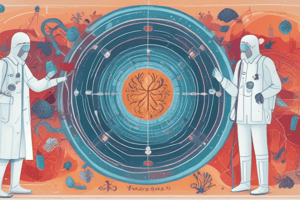Podcast
Questions and Answers
What is the incubation period in the context of infectious diseases?
What is the incubation period in the context of infectious diseases?
- The duration between infection and symptom appearance (correct)
- The time when specific symptoms appear
- The presence of symptoms without laboratory findings
- The recovery phase of the disease
Which of the following best describes asymptomatic infection?
Which of the following best describes asymptomatic infection?
- Infection with symptoms but no laboratory findings
- Infection that shows no signs or symptoms (correct)
- Infection with abnormal laboratory findings
- Infection that presents acute symptoms
What defines a focal infection?
What defines a focal infection?
- An infection affecting a specific organ or area (correct)
- An infection characterized by long-term symptoms
- An infection with no observable symptoms
- An infection that impacts the entire body
During which period do nonspecific general symptoms appear?
During which period do nonspecific general symptoms appear?
What is indicated by a chronic infection?
What is indicated by a chronic infection?
What is the phenomenon called when an infectious disease agent adheres and multiplies in a host's body without causing disease?
What is the phenomenon called when an infectious disease agent adheres and multiplies in a host's body without causing disease?
Which of the following is NOT a component of the epidemiological triad model?
Which of the following is NOT a component of the epidemiological triad model?
What are emerging infectious diseases characterized by?
What are emerging infectious diseases characterized by?
What does infection result in within a host's body?
What does infection result in within a host's body?
Which type of pathogen is classified as a living organism that can cause infectious diseases?
Which type of pathogen is classified as a living organism that can cause infectious diseases?
In the context of infectious diseases, what does the term 'pathogen' refer to?
In the context of infectious diseases, what does the term 'pathogen' refer to?
What year did infectious diseases account for over 45 million years lost due to disability?
What year did infectious diseases account for over 45 million years lost due to disability?
Which of the following factors is NOT considered an environmental factor in the epidemiological triad?
Which of the following factors is NOT considered an environmental factor in the epidemiological triad?
What distinguishes a latent TB infection from active pulmonary TB?
What distinguishes a latent TB infection from active pulmonary TB?
Which of the following best defines an epidemic?
Which of the following best defines an epidemic?
What is the primary role of a vector in infectious diseases?
What is the primary role of a vector in infectious diseases?
How does virulence impact an infectious agent?
How does virulence impact an infectious agent?
What is the significance of quarantine in disease control?
What is the significance of quarantine in disease control?
What is the definition of a pathogenic organism?
What is the definition of a pathogenic organism?
What characterizes a sporadic infection?
What characterizes a sporadic infection?
What differentiates a host from a pathogen?
What differentiates a host from a pathogen?
Study Notes
Infectious Diseases - General Approach
- Infectious diseases are caused by pathogens or their toxins.
- They are transmitted through infected people, animals, or contaminated objects.
- In 2013, infectious diseases resulted in over 45 million years lost due to disability and over 9 million deaths.
- Emerging infectious diseases are those that have newly appeared or are rapidly increasing in incidence or geographical range, such as Middle East Respiratory Syndrome (MERS), extensively drug-resistant tuberculosis (XDR TB), and Zika virus.
- The epidemiological triad model of infectious disease causation includes an agent (pathogen), the susceptible host, and the environment.
- The environment interacts with the host and agent, causing infection and disease.
- Infectious agents can be living parasites (helminths or protozoa), fungi, or bacteria, or nonliving viruses or prions.
- Environmental factors influence the exposure of the host to the agent and subsequent interactions between the agent and host determine exposure outcomes.
Stages of Infection
- After exposure, colonization occurs, which involves adherence and initial multiplication of a disease agent at a portal of entry, such as the skin or mucous membranes.
- Colonization itself may not cause disease.
- Disease occurs when a pathogen infects (invades and establishes within) host tissues.
- Infection can cause disruption without resulting in disease.
- Disease indicates a level of disruption and damage to a host, resulting in symptoms and signs of illness.
- Latent infection occurs when signs and symptoms are absent, but infection exists (e.g., latent TB infection).
- Active disease occurs when signs and symptoms of illness are present (e.g., active pulmonary TB).
Key Infectious Diseases
- HIV/AIDS
- Anthrax
- Influenza (H5N1)
- Resistant bacteria
- Hepatitis B and C
- West Nile fever
- Crimean–Congo hemorrhagic fever (CCHF)
- Ebola
- Resistant tuberculosis
- Malaria
- COVID-19
- Monkey Pox Virus
Major Causes of Global Mortality
- Lower respiratory tract infections
- Diarrheal diseases
- HIV/AIDS
- Malaria
- Tuberculosis
Key Definitions
- Disease: A pathological condition identified in a region, organ, or tissue of the body, causing signs and symptoms.
- Infectious disease: A disease caused by infectious agents.
- Infection: The entry and reproduction of an infectious agent in the human body, with or without a disease picture.
- Pathogen: An infectious agent that creates the disease picture.
- Host: The organism where the infection occurs.
- Virulence: The ability to cause disease.
- Endemic: The occurrence of a disease with a certain or habitual frequency in a population.
- Epidemic: The occurrence of an infectious disease in a region more than expected in a short time.
- Pandemic: A very large epidemic affecting a continent or continents.
- Sporadic: An infection occurs as sporadic cases in an area.
- Isolation: Separation of the infected person from other people during transmission.
- Quarantine: Restricting the freedom of movement of people or animals that come into contact with a contagious disease during the contagious period of the disease.
- Vector: Animals that carry the infectious agent, such as flies, lice, ticks, and mice.
- Porter: Persons and animals that do not show signs of illness but carry a microorganism and transmit it to others.
- Incubation period: The period between the introduction of the infectious agent into the host and the appearance of disease symptoms.
- Prodromal period: The period in which nonspecific general symptoms appear before the specific symptoms of the infectious disease.
- Disease period: The period in which the disease is observed.
- Convalescent period: The recovery period of the disease.
- Asymptomatic infection: Infection with no symptoms or signs (clinical or laboratory).
- Subclinical infection: Infection without symptoms but with abnormal laboratory findings.
- Acute infection: The period when the disease progresses with acute symptoms and both clinical and laboratory findings are seen.
- Latent infection: After acute infection, the microorganism settles in different cells of the body and continues to live without any signs or symptoms.
- Chronic infection: Used to describe long-course infectious diseases.
- Focal infection: Infection that affects a particular area or organ of the body.
- Systemic infection: Infection that affects the whole body and systems.
Infectious Disease Resources
- People
- Animals
- Inanimate environment:
- Water
- Foods
- Soil
- Things
Infectious Agents
- Bacteria
- Viruses
- Parasites
- Fungi
Studying That Suits You
Use AI to generate personalized quizzes and flashcards to suit your learning preferences.
Related Documents
Description
This quiz explores the general principles of infectious diseases, including their causation, transmission, and impact on public health. It highlights the key components of the epidemiological triad and the role of emerging diseases. Test your understanding of the mechanisms behind these infectious agents and their effects on society.




